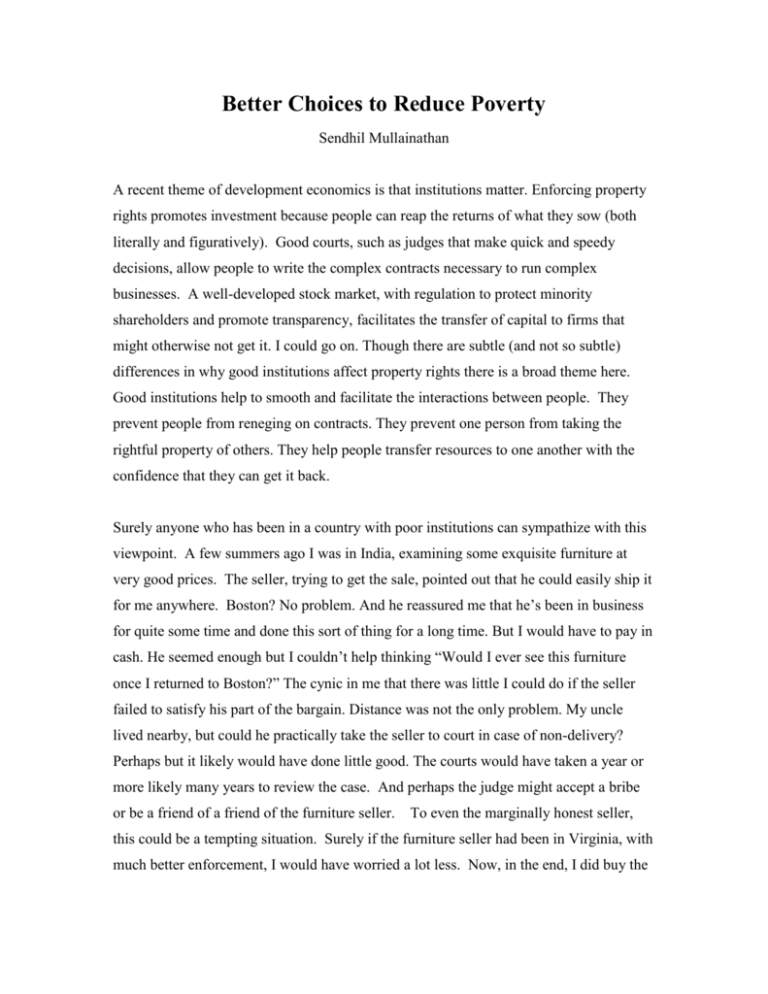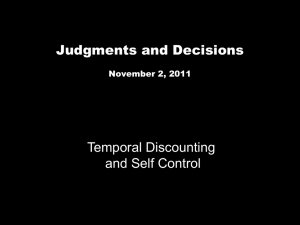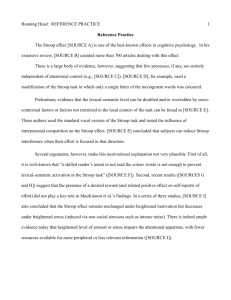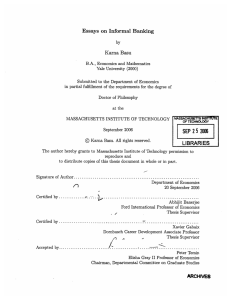Mullainathan-AbBook311
advertisement

Better Choices to Reduce Poverty Sendhil Mullainathan A recent theme of development economics is that institutions matter. Enforcing property rights promotes investment because people can reap the returns of what they sow (both literally and figuratively). Good courts, such as judges that make quick and speedy decisions, allow people to write the complex contracts necessary to run complex businesses. A well-developed stock market, with regulation to protect minority shareholders and promote transparency, facilitates the transfer of capital to firms that might otherwise not get it. I could go on. Though there are subtle (and not so subtle) differences in why good institutions affect property rights there is a broad theme here. Good institutions help to smooth and facilitate the interactions between people. They prevent people from reneging on contracts. They prevent one person from taking the rightful property of others. They help people transfer resources to one another with the confidence that they can get it back. Surely anyone who has been in a country with poor institutions can sympathize with this viewpoint. A few summers ago I was in India, examining some exquisite furniture at very good prices. The seller, trying to get the sale, pointed out that he could easily ship it for me anywhere. Boston? No problem. And he reassured me that he’s been in business for quite some time and done this sort of thing for a long time. But I would have to pay in cash. He seemed enough but I couldn’t help thinking “Would I ever see this furniture once I returned to Boston?” The cynic in me that there was little I could do if the seller failed to satisfy his part of the bargain. Distance was not the only problem. My uncle lived nearby, but could he practically take the seller to court in case of non-delivery? Perhaps but it likely would have done little good. The courts would have taken a year or more likely many years to review the case. And perhaps the judge might accept a bribe or be a friend of a friend of the furniture seller. To even the marginally honest seller, this could be a tempting situation. Surely if the furniture seller had been in Virginia, with much better enforcement, I would have worried a lot less. Now, in the end, I did buy the furniture (and actually received it). But who knows how many such transactions are hindered every day by these poorly functioning institutions? While compelling, I think this picture—that good institutions help facilitate transactions between people—is incomplete. I think good institutions also help to reduce the problems that arise within a person. This kind of statement is hard to make sense of with standard economic reasoning. Individuals are rational, autonomous units with full self-control. This framework doesn’t leave room for people to have problems with themselves so what could institutions help with? I am one of a growing set of researchers who studies how to integrate psychological insights into economic reasoning. In this perspective, people sometimes make bad choices, ones that they themselves would like to improve on. This perspective is opening up new ideas such as how good institutions, in some contexts, might help people improve their decisions. I will discuss these insights using a few choice examples. My goal here is not to tell you about concrete policies that might emerge. It is a bit early for that. Instead it is to give you a glimpse of how radically different our policy suggestions might be in ten or twenty years as the integration of psychology and economics deepens. Active versus Passive Choices The standard economic model assumes all choices are decisions. Individuals weigh the benefits and costs of one action versus another and then choose the one that fits them most. In many cases this makes sense. I end up on vacation in Bermuda, rather than Jamaica, through a series of explicit and conscious actions designed to choose the locale that will give me the greatest pleasure. I read through various guidebooks and talk to friends. I try to examine the relative benefits of Bermuda (much closer) and costs (less to do), weigh them and come to a conclusion. Perhaps I over-weighted one dimension or another but at least my decision was an active one. Economics assumes all choices occur in this conscious, active manner. Yet many of the choices we make, even big ones, are not active ones. Why does my email go unread for days (weeks! months!)? At no point did I decide this would be what is best for me (surely it isn’t). Instead it overflowed because there was never a point where I chose otherwise. In fact, it is because I never sat down to make this decision that I ended up with a mailbox too large. Part of the reason for this is procrastination and a lack of self-control. Part is that other things got in the way. This distinction is not just a philosophical one. A growing body of research suggests that this distinction may be very important for understanding various important decisions. The idea that many decisions may be passive ones draws on a large set of psychology experiments that we often process information automatically, without it every entering our conscious realm. Perhaps the most salient (and certainly most fun) demonstration of this principle is the Stroop test (Stroop 1935). Try and read the words in Figure 1. Do you find it difficult? Hopefully not. Now try and read the words in Figure 2. Do you find that difficult? Unless you are color blind, you should. The reason is simple. Your brain is automatically processing the color of the ink before other parts (the slower ones presumably) engage in the task of reading what the letters actually say. This interference makes it hard to read the word. One way to think about the Stroop task is attention. The color the words are written in draws attention away from the words themselves. In some sense, this is also the source of my problem with e-mail. Other tasks drew my attention away from dealing with it. In the same sense that I do not choose to misread the word “Red”, I do not choose to let my email pile up. Red Blue Yellow Green Blue Green Yellow Red Blue Green Green Red Green Red Yellow Red Yellow Green Blue Red Blue Green Blue Red Yellow Red Blue Red Red Blue Yellow Green Blue Green Yellow Red Green Red Blue Green Red Yellow Red Green Green Blue Red Yellow Blue Green Blue Red Red Blue Red Yellow Figure 1: Stroop Test Passive decision-making can even affect large decisions. Consider an economically important decision such as how much to save. How do people make this decision? In the traditional model, people trade-off consuming more today against consuming less in the future or when retired. They assess their assets, their future earnings (and the riskiness of those earnings), their projected Social Security payments and their expected lifespan and use these factors to decide how much they need to put away. But all this assumes that savings is a calculated, active decisions. Is this really the case? Some evidence suggests otherwise. In one survey, 76 percent of Americans believed that they should be saving more for retirement. In fact, 55% felt they were behind in their savings and only 6% reported being ahead (Farkas and Johnson 1997). Though they want to save, many never get around to it. Perhaps they meant to save but an appealing purchase reared its head and they lacked the self-control to resist. Perhaps other tasks simply garnered their attention and they never got around to organizing their finances in such as a way as to actually accomplish their planned savings rate. Madrian and Shea (2003) conducted a particularly telling study along these lines. They studied the choice to participate in a 401(k) plan. People when they join the firm typically are given a form that they must fill out in order to participate. 401(k)s are very lucrative so people have very incentive to participate. Yet participation rates are quite low. Standard economic models might suggest that the subsidy ought to be raised. Many firms in fact do this. But still participation rates are low and the programs are quite expensive. Madrian and Shea (2003) study a firm who changed a very simple feature of its 401(k) program. Prior to the change, new employees received a form that said something to the effect of “Check this box if you would like to participate in a 401(k). Indicate how much you’d like to contribute”. After the change, however, new employees received a form that said something to the effect of “Check this box if you would like to not to have 3% of your pay check put into a 401(k)”. By standard reasoning, this change should have little effect on contribution rates. How hard is it to check off one box? After all, that’s the only difference between the two conditions. In practice, however, Madrian et. al. find a large effect. When the default option is to not contribute, only 38% of those contributed. When the default option was contribution, 86% contributed. Moreover, even several years later those exposed to a contribution default still show much higher contribution rates. These results are consistent with (and motivated) the discussion above. While we cannot be sure from this data what people are thinking, I would speculate that some combination of procrastination and passivity played a role. Surely many looked at this form and said, “well I’ll decide this later”. But later never came. Perhaps they were tempted by more other than deciding on 401(k) contribution rates (hard to believe, but there are more interesting activities). Perhaps it simply slipped out of their attention because other factors came to occupy it. In either case, whatever the default on the form was, they ended up with. In fact, as other psychology tells us, as time went on they may well have justified their “decision” to themselves by saying “5% is what I wanted anyway” or “that 401(k) plan wasn’t so attractive. In this way, their passivity made their decision for them. By making the small active choice to choose later, they ended up making a large decision about thousands of dollars of money. These kind of passive choices occur in many aspects of savings. When I teach saving to my graduate students, I often tell them that “savings is simply what you don’t spend”. Partly I’m being facetious, but partly I am serious at this distinction. Some people sit down with a budget and decide how much they’re going to save (and some of them even stick to that decision! but more on this later). For the rest of us, savings is just what is left over after we’ve made all our active decisions about what to buy. This is why many of the institutions that help us save do so by simply getting to the money before it ever enters our hands. As we’ve seen, firms automatically deduct money for 401(k) contributions. Another example is mortgages. I often suggest to friends to buy the biggest house they can. Most avoid doing this because they don’t want to spend all their money on housing. They’d like to save some of it in other means. While this is an eminently sensible plan, it is not what happens. Inevitably the money not put into housing finds some other way of being spent, rather than being saved. What makes the mortgage such a good savings device is that it is automatic. Each month, a payment must be made. These insights can also help us design whole new institutions. One example is Save More Tomorrow, a program created by Benartzi and Thaler. The basic idea of Save More Tomorrow is to get people to make one active choice. But to have them make it in such a way that if they remain passive afterwards they are still saving. Think of why housing is such a good savings device. You decide once to buy it and then forever more (well, probably only 30 years but it certainly feels like forever), you’re committed to keep putting money into it. Save More Tomorrow works on a similar principle though without such a strong commitment. Individuals are offered a chance to participate in this program. To participate, they decide on a target savings level (and we know from before that people actually want to save). Once they decide on what they’d like to save, they agree to start 401(k) deductions at a small level from their paycheck next year. And then each year, as they receive a raise their deductions increase until they hit their target savings level. They can opt out of the program at any time. But the genius is that if they do nothing and remain passive, they will continue to save (and even increase their savings rate). The results have been stunning. In one firm, for example, more than 75% of those offered the plan participated in it rather than simply trying to save on their own. Of these, interestingly few of them (less than 20%) opted out. As a result savings rates went up sharply. By the third pay rise (as the default increases cumulated), individuals had more than tripled their savings rates. But perhaps the greatest success has been the diffusion of this product. Many major firms and pension fund providers are thinking of adopting it and participation in the program will likely soon number in the millions. Save More Tomorrow is a trademark for what psychologically smart institutional design might look like in the future. It does not solve a problem between people but instead helps solve a problem within the person: not saving as much as they would like. It does so by harnessing a variety of psychological tools. Besides the one I’ve highlighted it also relies on two others. First, it asks people to save out of future raises. In that sense they are saving money that they don’t have currently, money that isn’t already budgeted for one thing or another. It’s much easier to put future money to savings (a foregone gain) rather than bear a loss now by cutting back on some valued consumption. Second, it relies on the The insights I’ve highlighted from this research can help speed up the process of development in many ways. One direct way is to recognize that many institutions in developing countries work well because they encourage good default behaviors. Some of these institutions can be transplanted. Automatic deduction of paychecks, for example, to a separate savings account could be a very powerful savings device. The highly regulated banks that populate developing countries are unlikely to implement innovations such as these on their own. But with effort and prodding they can be transplanted in my opinion. If transplanted, for some part of the population at least, these kinds of institutions might allow savings (rather than not saving) to become the default. Of course many in developing countries do not have bank accounts. For the unbanked, these insights serve to strengthen or reinforce an existing policy suggestion: increase the scope of banking services. In the existing view, increasing access to banking services is good because it increases the amount of capital in the banking system and perhaps raises the return on savings for some. In joint work with Marianne Bertrand and Eldar Shafir, however, I’ve argued that a more sophisticated view of human psychology reveals numerous other advantages of a bank account. First, it takes money further away from the individual. So in many cases the passive choice or procrastination leads to not spending. When money is around, active effort is required to save it away. When money is in the bank account, active effort is required to go and get it in order to spend it. Second, and relatedly, it forces people to attend to what they are actually taking out and spending. What we want and what we do Even when we do sit down and actively make a decision, we may not always have the will power to carry through on that decision. I had decided actively to write this paper a year and a half ago and am only writing it now. I alluded earlier to procrastination and lack of self-control is one of the prime reasons for procrastination. That we lack less than full self-control is a growing part of economic discourse. The savings example has once again been the center of this discussion. Recall the survey evidence on desired savings. Surely some of the reasons people do not meet their desired savings level is that they do not have the will-power to implement their plans. One way institutions can help solve these self-control problems is by committing them to a particular path of behavior. A common analogy here is with Ulysses, who has himself tied to his ship’s mast, so that he can listen to the song of the sirens but no be lured out to sea by them. While not so dramatic, commitment devices exist in everyday life. Many refer to their gym membership as a commitment device (“Being forced to pay that much money every month really gets me to go to the gym lest I waste it”.). Christmas clubs, while less common than before, used to be a very powerful commitment tool for saving to buy Christmas gifts. Smokers not having cigarettes around or dieters not buying appealing snacks are all examples of commitment devices. Financially, pension plans, automatic drafts from checking to investment accounts, and direct debits from paychecks all help at least partly to commit behavior. Commitment devices for savings also appear in developing countries. For example, Roscas might serve as a commitment device (Gugerty 2003). In a Rosca, a group of people meets together at regular intervals. At each meeting, members contribute a prespecified amount. The sum of those funds (the “pot” so to speak) is then given to one of the individuals. Eventually, each person in the rosca will get their turn and thus a return on their contributions. While roscas often pay little or no interest and the participants bear the risk that others may drop out after getting the pot, they are immensely popular. One reason for their popularity may be that they offer a commitment device. They may help to save by providing pressure to put aside money regularly (Ardener and Burman 1995). As some rosca participants say, “you can’t save alone”. The social pressure to save may bind their hands and serve as an effective commitment device to put aside regularly. Commitment devices may also appear in the guise of durable goods. People may commit themselves by saving in kind rather than in cash, which is far too tempting to spend. People may hold their wealth in items such as Jewelry, livestock, and grain because these items are harder to dip in to. What can policy do? They can provide cheaper and more efficient ones than what little exists now. After all, even if saving in grain provides commitment it is an expensive way to do so. Vermin may eat the grain and the interest rate earned on the grain could be zero or even negative. Moreover, it is important to recognize, that even if people demand such commitment devices, the free market may not do enough to provide them. The highly regulated financial markets of developing countries may lead to too little innovation on these dimensions. Monopoly power may also lead to inefficient provision of these commitment devices depending on whether a monopolistic financial institution can extract more profits by catering to the desire for commitment or to the temptations themselves. In this context, governments, NGOs and donor institutions can play a large role by promoting such commitment devices. Government policy can also be improved by understanding the power of temptation and the desire to avoid it. This understanding could turn some conventional logic on its head. For example, in designing saving policies, standard logic dictates that the more liquid an account the more valuable. After all, liquidity allows people to be able to free up cash to attend to immediate needs that arise. If a child gets sick, money is needed to pay for medicine. This might be especially true for the poor. Shocks that are small for the well off can be big for the poor and they would need to dip into real savings to address them. Yet despite this force, the poor may value illiquidity. Ashraf et. al. give a stunning illustration. They offer savers in the Philippines the opportunity to participate in lockbox savings accounts. The accounts are literal lockboxes, where the bank has the key. Individuals can put aside small amounts of cash (as they want to)in to the lock box. Every one to two weeks they deposit the box with the bank that in turn deposits the contents of the lockbox into an account. They also test a savings vehicle where a certain amount of money of all deposits are automatically set aside each month into a separate account. Money cannot be withdrawn from this account until a predefined event occurs (such as planting season or a certain target has been reached). Both savings tools are very illiquid. Yet they find large demand for them. The recognition that illiquidity can be a net good is a very important policy lesson. The creation of market institutions that increase liquidity may be a net bad, not a net good. Such caveats will force us, I feel, to reconsider the full set of financial market policies in developing countries. Though the bulk of my examples have been from savings, I think policy in many other areas may also be affected. One salient example is in potentially addictive substances such as with alcohol or smoking. The economist’s approach to such goods has been to treat them as any other good: people choose them willingly (or in the extreme case, people willingly choose to be addicted to them). Yet there is some evidence that this is not the case. For example, in a recent study I did with Jon Gruber, we found that smokers are made better off by rising cigarette taxes. When states increased their taxes, we found increases in self-reported happiness of those who tend to smoke. Cigarette expenditures are a big part of expenditures especially for the poor and the cigarette tax, we argue (and others have found), helps those trying to quit to actually do so. Thus the tax helps them do something they’ve been trying to do. Much like the lockbox puts tempting money out of reach, the taxes may put cigarettes out of (financial) reach. This is the exact opposite of the standard arguments make about taxes. When economists suggest taxes to alter behavior, it is to deal with externalities, to alter behavior that negatively affects others. In this case, behavior changes, but the benefits accrue to the individuals themselves. In other words, taxation here may (in a few cases) actually be an institution to help people solve problems with themselves. In the developing country context, such distortions could potentially be even more severe since these expenditures would form a sizable bulk of consumption. Cite evidence. Because the costs of alcohol and cigarettes are such a large portion of income, addiction to them could be very costly in real terms. Perhaps there is room for tax (or regulatory) policies in these cases as well. Of course, these policies are not firm suggestions. It is too early to say that a tax on cigarettes is always a good. We simply do not have enough evidence. But thinking about self-control problems and how government policies interact with them is beginning to produce some extremely interesting insights; ones that I think will eventually change the way development policy is done. Conclusion Despite the psychological evidence I cite, I am constantly surprised at some of the empirical evidence. For example, how can a simple default have such a large effect on behavior? How can the cost of checking the box be enough to drive such large decisions? I think this is one of the central messages of psychology for economics, especially when trying to design institutions. Small differences can affect large behaviors. Getting an institution right is partly about getting the broad theme of it correct. Psychology can help us with that, such as in thinking about commitment devices. But it is in large part about getting the very micro-details right. What is the default? How are the choices framed for the person? I think psychology will revolutionize the way we re-design the institutions of developing countries and, hopefully, in the process help to alleviate poverty. References Ardener, Shirley and Sandra Burman, eds. 1995. “Money-go-Rounds: The Importance of rotating savings and credit associations for women.” Washington, D.C. BERG. Ashraf, Nava, Nathalie Gons and Wsley Yin, 2003, “Testing Savings Product Innovations Using an Experimental Methodology,” mimeo. Benartzi, Shlomo and Richard H. Thaler, 2001, “Save More Tomorrow: Using Behavioral Economics to Increase Employee Saving,” mimeo. Farkas, Steve and Jean Johnson, 1997. “Miles to Go: A Status Report on Americans’ Plans for Retirement,” published by Public Agenda. Gruber, Jonathan and Sendhil Mullainathan, 2002, “Do Cigarette Taxes Make Smokers Happier,” mimeo, MIT. Gugerty, 2003, Mary Kay, “You Can’t Save Alone: Testing Theories of Rotating Savings and Credit Associations in Kenya,” mimeo. Madrian, Brigitte and Dennis Shea (2001). “The Power of Suggestion: Intertia in 401(k) Participation and Savings Behavior,” Quarterly Journal of Economics Vol. 116 (4): 1149-1187. Stroop, J. Ridley, 1935, “Studies of Interference in Serial Verbal Reactions,” Journal of Experimental Psychology, 18, pp. 643-662.






